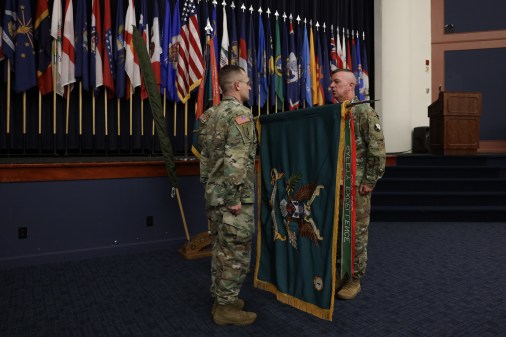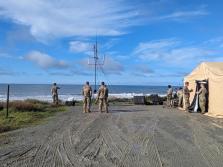Navy’s Pacific information warfare command coordinating vast capability across region

The Navy’s recently created Fleet Information Warfare Command Pacific is proving invaluable to the region, particularly when it comes to coordinating and integrating the capabilities of various tactical entities, according to officials.
One of the reasons for the FIWCPAC‘s standup in 2022 was to help coordinate effects across the vast information space, including through interservice and allied partners.
Pacific Fleet commander Adm. Samuel Paparo requested the organization “to be stood up to focus specifically on the integration of information operations and his whole campaign in the Pacific,” Vice Adm. Kelly Aeschbach, commander of Naval Information Forces, said during an event Tuesday hosted by Navy Memorial.
While there are tactically oriented information warfare entities, they lack authority and responsibility to integrate capabilities at the operational level and across other Department of Defense capabilities.
“The O-6 Information Warfare Commanders on our Carrier Strike Group staffs provide outstanding capability at the tactical level, but lack the position, authority, and scope of responsibility to integrate at the operational level and across the breadth of DoD capabilities,” a Pacific Fleet spokesperson told DefenseScoop.
Several years ago, the Navy created O-6 level information warfare commanders as permanent fixtures within carrier strike groups and is currently piloting a similar effort within its submarines.
“As an Echelon III command, FIWCPAC provides the fleet with the ability to synchronize, align, and integrate information related capabilities across the joint force, to include U.S. Space Command (USSPACECOM), U.S. Cyber Command (USCYBERCOM), the U.S. Indo-Pacific Command (INDOPACOM) service components, and others, to enable joint force speed, action, and maneuver across the competition continuum,” the spokesperson said. “FIWCPAC is able to coordinate on our tactical commanders’ behalf to provide these wide-ranging capabilities in support of tactical and operational actions.”
Across the joint force, as these types of information warfare capabilities are gaining in importance, it is becoming more evident that higher-level coordinating organizations are necessary. Historically, these capabilities have not been well understood or have been an afterthought, leading to their neglect, or the authorities needed reside at a higher level — leading to confusion over what can be done.
As a result, more and more entities are being created to help integrate at the theater level, to include the Marine Corps Information Command and the Army’s Theater Information Advantage Detachment.
When it comes to integration, the Pacific Fleet spokesperson said there have been several “grassroots” efforts across the other services, to include the TIAD, the Marine Expeditionary Force Information Groups and others. While these relationships are in their early stages, they will be essential for rapid and cohesive joint effects, the official added.
Additionally, during a recent exercise, Pacific Sentry, FIWCPAC strengthened its relationship with the Army’s 8th Psychological Operations Group, receiving planning augmentation from them to bolster influence efforts. This resulted in “unprecedented levels of success, planning and executing” joint information operations in support of U.S. Indo-Pacific Command, during the exercise, according to the spokesperson.
The Naval Information Warfighting Development Center, the Navy’s “top gun” school for information warfare, is providing direct support to FIWCPAC with personnel for additional planning capacity. Both organizations are developing information operations tactics, techniques and procedures as well as concepts of operations to support Indo-Pacom.
FIWCPAC also co-hosted a first of its kind conference in December 2022 focused on operations in the information environment. The event brought in partners from the joint force across Indo-Pacom to improve synchronization, coordination and integration of these capabilities for the combatant command.
FIWCPAC is also working with foreign partners in the region in a variety of aspects, including exposing malign activity. Other efforts have involved leadership meetings with Japanese and Australian counterparts to discuss common approaches to executing the information effects cycle. These efforts have improved Indo-Pacom’s ability to integrate these information capabilities with allies, the spokesperson said.
Despite FIWPAC’s success, there aren’t any immediate plans to create similar organizations across the Navy.
“The decision to establish another FIWC would be at the Fleet Commander level,” Aeschbach told DefenseScoop in a statement.
“Information Warfare is integral to Fleet and joint operations, and there is a growing demand for IW capabilities at the Fleet Commander level. Fleet Information Warfare Command Pacific’s efforts over the last year have been impactful to operating and maneuvering in the information space, and the Navy is garnering lessons learned from FIWC PAC to inform how IW can best be integrated with fleet operations and delivered to fleet commanders,” she added.






